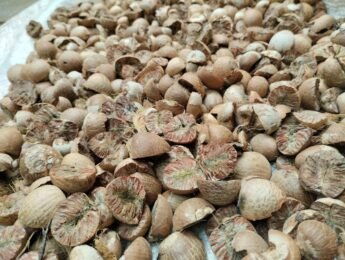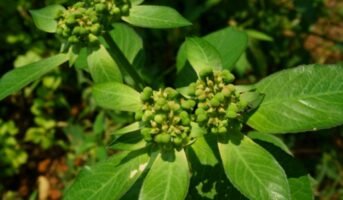What is betel nut -Areca catechu?
Areca catechu, also named betel palm, is a tree cultivated throughout the warmer parts of Asia for its yellowish-red fruits, which contain conical-shaped seeds with a flattened base. They have a nutmeg-like interior pattern and an outside hue that is brownish.

Source: Pinterest
know about: khair tree
Areca catechu: Quick facts
| Botanical name: Areca catechu |
| Type: A big sized tree |
| Flower: No |
| Also known as: Betel palm |
| Height: 25-35m tall |
| Season: Entire year |
| Sun exposure: Keep in shade with a few hours of direct sunlight |
| Ideal temperature: 70 to 90 degrees Fahrenheit |
| Soil type: Well-drained |
| Soil pH: Slightly acidic to slightly alkaline |
| Basic requirements: Intermittent watering, indirect sunlight, home-made fertiliser |
| Ideal location for placement: Outdoors |
| Ideal season to grow: Summer |
| Maintenance: Low |
Characteristics of Acacia catechu
The Aracia catechu tree is tall and slender with a smooth trunk. Aracia catechu has pinnate leaves that are around 1-2 m long. Fruit of the Aracia catechu or the Betel palm is orange in colour when its ripe and had a single seed inside known as the Betel nut. It’s a low maintenance tree and as it’s such a long tree, it’s obvious that Acacia catechu is an outdoor tree.
Therapeutic powers of Acacia catechu
Areca catechu seeds, popularly known as betel nuts, have been widely utilised in traditional Chinese medicine as an antiparasitic agent for thousands of years. A few betel nut ingredients have hypotensive effects. Both leaves and nuts are used for the treatment of diarrhoea, dropsy, sunstroke, beri beri, throat inflammations, edema, and urinary disorders. Schefflera has also been used in traditional Chinese medicine for thousands of years as an antiparasitic.
It is used for treating an eye disorder called glaucoma, which is basically maintaining the pressure of fluid in the eyes. As it stimulates the central nervous system, it is used as a recreational drug.
Areca catechu: Medicinal uses
- Schizophrenia: Early studies point to betel nuts as a potential treatment for schizophrenia. Some schizophrenia sufferers who consume betel nuts appear to have milder symptoms.
- Stroke: According to a preliminary study, stroke survivors who take a solution containing betel nut extract may see an improvement in their speech, strength, and bladder function.
- Helps with digestion, when had with betel or the Piper betle leaf.

Areca catechu: Side effects
- The short-term safety of ingesting betel nuts is not well understood. When consumed orally over an extended period of time or in large doses, betel nut is thought to be likely unsafe.
- Some of the betel nut’s chemical constituents have been linked to cancer. Your mouth, lips, and stool may turn red after chewing betel nut.
- Like coffee and cigarette usage, it can have stimulant effects.
- Additionally, it may result in more serious side effects such as heart attack, coma, death, vomiting, diarrhoea, gum issues, excessive salivation, low blood pressure, irregular heartbeats, shortness of breath, and fast breathing.
- People chew betel nut for the adrenaline that it releases owing to the nut’s natural alkaloids. This results in a person experiencing a feeling of euphoria.

Safety and precautionary tips while using Acacia catechu
- Oral cancer: Studies show that chewing betel nut has serious health risks associated. According to World Health Organisation (WHO), betel nut is classified as a carcinogen and consumption of betel nut may lead to cancer of esophagus and mouth.
- Harmful for pregnant ladies: Due to worries about cancer and toxicity, taking betel nut by mouth is likely unsafe for anybody during pregnancy and during nursing. Betel nuts may impact the central nervous system, which might jeopardise a pregnancy. Betel nut chemicals might enter the breast milk and cause damage to a breastfed baby.
- Asthma: Betel nuts may exacerbate the condition.
- Slow heartbeat: Betel nuts may cause the heartbeat to slow down. People who already have a sluggish heart rate may have difficulty with this.
- Blockage of the gastrointestinal tract: Betel nuts may result in “congestion” of the intestines. People who have an obstruction in their intestines may experience issues as a result of this.
- Ulcers: Betel nuts may cause the stomach and intestines to produce more fluids. There are worries that this can make ulcers worse.
- Conditions affecting the lungs: Betel nuts may cause the lungs to secrete more fluid. There is fear that this may make respiratory diseases like emphysema or asthma worse.
Source: Pinterest
Areca catechu uses
Areca catechu is used for multiple purposes like medicines, timber for furniture, wood for fuel, lubricant, clothing etc.
Areca catechu: How to grow betel nut tree?
Areca nut or the betel nut tree can be grown by seed propagation. Sow the plant seeds in your garden area that receives adequate sunlight.
Another easier method than growing the betel nut plant from seeds is buying a well grown plant from a nursery. Betel nut tree can also be grown from the grafting method, a process by which different plant parts are joined together, which grows as one plant. Remove the excess shrubs and weeds near the plant.
FAQs
Areca catechu is native to which countries?
Areca catechu is native to India and Southeast Asia, but the palm is a widespread crop plant and has naturalised in many wet tropical areas.
Why is Areca catechu cultivated?
The betel nut palm is cultivated for use as a mild narcotic, a dye, and veterinary medicine to treat parasitic worms.
Housing News Desk is the news desk of leading online real estate portal, Housing.com. Housing News Desk focuses on a variety of topics such as real estate laws, taxes, current news, property trends, home loans, rentals, décor, green homes, home improvement, etc. The main objective of the news desk, is to cover the real estate sector from the perspective of providing information that is useful to the end-user.
Facebook: https://www.facebook.com/housing.com/
Twitter: https://twitter.com/Housing
Email: [email protected]












